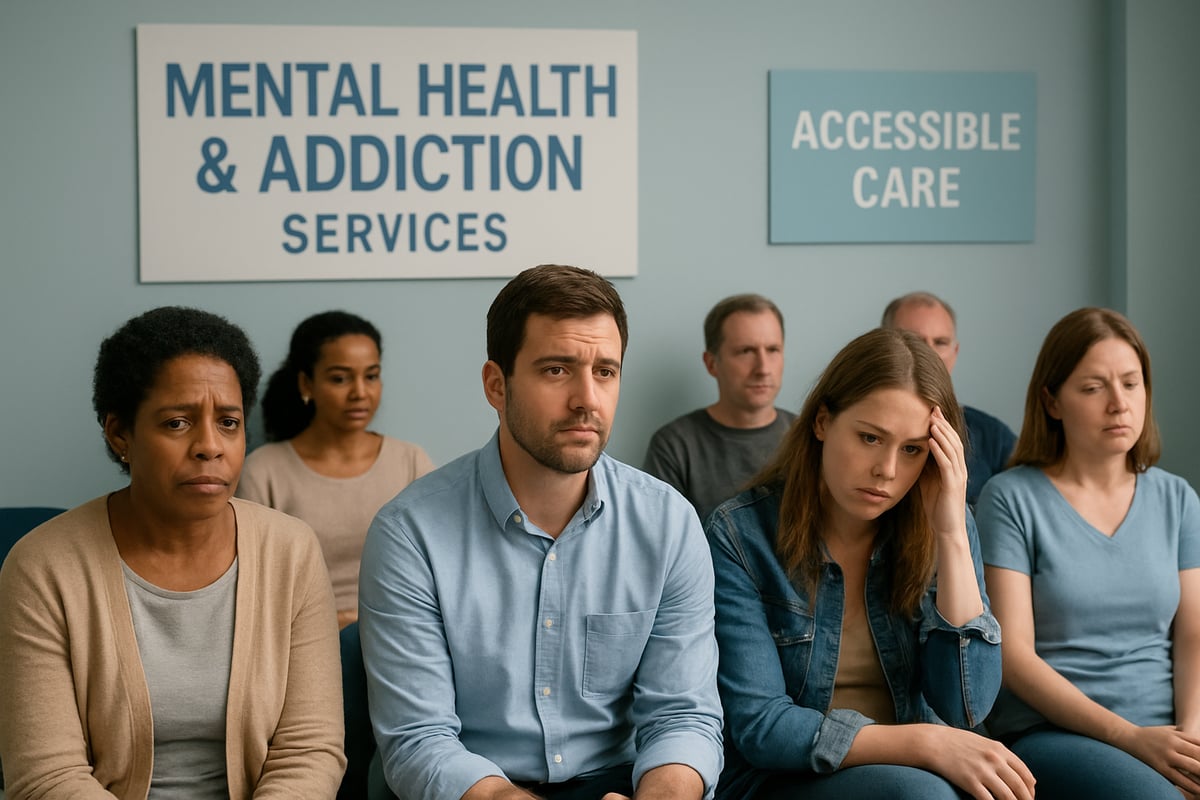In 2025, the difference between treatment and truly effective treatment can be life-changing. As healthcare evolves rapidly, understanding what makes treatment effective is more crucial than ever. This guide will walk you through the latest definitions, key challenges, and proven strategies that drive real results in patient care.
We will explore how technology, personalization, and ongoing support are shaping outcomes. You will discover the critical steps every patient, provider, and family should know to make treatment effective. Get ready for practical, evidence-based insights you can trust.
Defining Effective Treatment in 2025
In 2025, the meaning of “treatment effective” has evolved. It is no longer defined by simply addressing symptoms. Instead, it reflects a holistic approach that values sustainable recovery, patient involvement, and measurable progress. Healthcare providers and patients now expect more than a short-term solution—they seek outcomes that last.

Understanding “Effective” in Modern Healthcare
The definition of treatment effective in 2025 centers on patient-centered outcomes, updated medical guidelines, and the shift from acute to chronic care models. This shift is especially clear in mental health and addiction treatment, where long-term management is essential. Modern approaches emphasize evidence-based practices and measurable results.
A striking example is a recent global study showing only 6.9% of mental and substance use disorders received guideline-consistent care across 21 countries. For more details, see the Effective Treatment for Mental and Substance Use Disorders in 21 Countries report. This statistic highlights the urgent need for compassionate, timely, and accessible treatment effective strategies that improve both clinical outcomes and patient quality of life.
Core Components of Effective Treatment
Key elements that make treatment effective include timely access to care, appropriate treatment duration, integrated care, and ongoing support. For chronic conditions, detox is only a starting point. Long-term management, often lasting at least three months, is critical for meaningful progress.
Effective treatment also requires both medical and psychosocial interventions. In addiction recovery, for example, combining medication with counseling leads to better results. Mental health protocols now recommend integrated approaches, ensuring that treatment effective solutions address the whole person, not just the diagnosis.
Measuring Outcomes and Success
A treatment effective approach is measured by more than symptom reduction. Metrics now include relapse rates, patient satisfaction, and improvement in daily functioning. Digital health tools and data analytics help track progress, enabling providers to adjust plans in real time.
Low perceived need for care remains the largest barrier, affecting nearly 46.5% of those who might benefit. Real-world outcome-based models show that ongoing assessment and flexibility are key. This ensures that treatment effective strategies remain responsive, supporting sustained recovery and improved quality of life for patients.
Barriers to Effective Treatment: What Holds Us Back?
Barriers to making treatment effective are complex and interconnected, impacting both access and outcomes for patients worldwide. Understanding these obstacles is the first step toward overcoming them and ensuring that every individual receives the care they need.

Systemic and Structural Challenges
Systemic factors often make treatment effective only for a fraction of those who need it. Underfunding in mental health and addiction services leads to long waitlists and limited provider availability. Many healthcare systems are fragmented, making coordination between primary care, specialists, and support services difficult.
Global disparities in access persist, especially in low and middle-income countries. Insurance coverage and socioeconomic status remain strong predictors of whether someone can access treatment effective for their condition. According to a recent international study, even in high-income nations, only a minority receive guideline-consistent care. These systemic issues create significant barriers to continuity and quality.
Patient-Level Obstacles
At the individual level, low perceived need for care is a major reason why treatment effective outcomes are not achieved. Nearly half of those with mental health or substance use disorders do not seek help because they do not recognize the severity or necessity of intervention. Stigma, misinformation, and lack of mental health literacy further discourage individuals from seeking support.
Motivation and readiness for change also play major roles. Cultural background and demographic factors can shape attitudes toward care, influencing engagement and follow-through. When patients do not feel understood or supported, the likelihood of achieving treatment effective results drops significantly.
Treatment Quality and Continuity Gaps
Receiving minimally adequate care is not enough to make treatment effective for most people. Studies show that only about half of those who get basic treatment reach meaningful improvement. Gaps in provider training, especially among general practitioners, lead to missed opportunities for early detection and comprehensive intervention.
Quality of care often suffers when services are not integrated or when follow-up is lacking. In addiction and mental health, short-term programs without ongoing support rarely deliver lasting change. These gaps reveal why a holistic, sustained approach is necessary for treatment effective outcomes.
Overcoming Barriers: Proven Strategies
To address these challenges, several strategies have shown promise in making treatment effective. Public awareness campaigns can reduce stigma and increase understanding of mental health needs. Provider education ensures that clinicians follow the latest evidence-based guidelines and can deliver integrated care.
Innovative models like Housing First, which offers stable housing as a foundation for addiction recovery, demonstrate the impact of addressing social determinants. Early intervention and robust support systems, including peer networks and family involvement, are essential for ensuring treatment effective results across diverse populations.
Step-by-Step Guide: Making Treatment Effective in 2025
Achieving truly effective care requires more than just starting treatment. In 2025, a structured approach can make any treatment effective, no matter the diagnosis. Let’s walk through each critical step, ensuring every patient receives the best chance at lasting recovery and improved health.

Step 1: Early Identification and Timely Access
The first step to making any treatment effective is recognizing issues early and providing immediate access to care. Delays can mean lost opportunities, especially for substance use or mental health crises.
Digital screening tools now allow for rapid identification of symptoms, connecting patients to care without lengthy waitlists. Telehealth platforms further reduce barriers, offering assessments and triage from home. When the process is streamlined, the likelihood of starting treatment effective at the right time increases.
- Immediate screening for high-risk conditions
- Telehealth for same-day consultations
- Digital triage for urgent cases
This approach ensures that readiness for change is met with real solutions.
Step 2: Comprehensive Assessment and Personalization
Every patient’s journey is unique, so comprehensive assessment is key to making treatment effective for all. Evaluations should cover co-occurring conditions, social determinants, and patient preferences.
Case studies show that addressing both addiction and mental health simultaneously leads to better outcomes. Individualized care plans, shaped by thorough assessments, help tailor treatment effective to each person’s needs.
- Assess for dual diagnoses
- Explore social and environmental factors
- Personalize goals and interventions
When care is individualized, engagement and success rates improve.
Step 3: Integrated, Evidence-Based Interventions
Combining medical, psychological, and social support is essential for treatment effective results. For example, medication-assisted treatment (MAT) for opioid use and cognitive behavioral therapy for mental health are proven strategies.
Provider training and adherence to current guidelines ensure interventions remain evidence-based. Yet, systemic barriers persist. For instance, Doctors Reluctant to Treat Addiction Most Commonly Report ‘Lack of Institutional Support’ as Barrier highlights the ongoing need for organizational backing to make treatment effective.
- Use of proven medications and therapies
- Ongoing provider education
- Integrated care teams
This integration boosts outcomes and patient satisfaction.
Step 4: Ensuring Continuity and Duration of Care
Lasting recovery requires care that extends beyond initial treatment. Research confirms that a minimum of three months is needed to make treatment effective for chronic conditions. Aftercare, supervision, and peer support are vital for relapse prevention.
Programs that focus on community reintegration and ongoing engagement consistently deliver better results. Structured follow-up and support networks transform short-term gains into long-term health.
- Minimum three-month duration for chronic issues
- Relapse prevention and peer networks
- Community-based aftercare
With this approach, the process of keeping treatment effective becomes sustainable for the future.
The Role of Technology and Innovation in Treatment Effectiveness
Technology is transforming what it means to make treatment effective in 2025. Digital innovations now touch every stage of care, from assessment to aftercare. These advances offer new ways to reach patients, personalize support, and measure real progress.

Digital Tools for Assessment and Monitoring
Digital tools now play a central role in making treatment effective for both patients and providers. Mobile apps help track symptoms, medication adherence, and emotional wellbeing. Wearable devices monitor vital signs, sleep, and activity, providing real-time data to clinicians.
Telemedicine platforms have made it possible to conduct assessments remotely, reducing delays in receiving care. AI-driven analytics can detect early signs of relapse or crisis, allowing for timely intervention. For example, innovative chatbot solutions like ChatThero: An LLM-Supported Chatbot for Behavior Change and Therapeutic Support in Addiction Recovery are being used to enhance patient engagement and deliver 24 7 support.
These tools allow for continuous monitoring and more personalized care, making treatment effective even outside traditional clinical environments.
Data-Driven Decision Making
Data-driven approaches are essential for keeping treatment effective in a fast-changing healthcare landscape. Providers use digital dashboards and electronic health records to track patient progress and outcomes over time.
Outcome data, such as symptom reduction or relapse rates, guide adjustments to treatment plans. Feedback loops based on real-world evidence ensure interventions remain current and relevant. Automated reminders and digital surveys help gather patient-reported outcomes efficiently.
By leveraging these data sources, care teams can intervene earlier and optimize strategies, ensuring each step in the process makes treatment effective for individuals and populations alike.
Expanding Access and Reducing Disparities
Technology is also a powerful tool for making treatment effective in underserved communities. Telehealth bridges gaps in care for rural or remote populations, bringing specialists and support directly to the patient’s home.
Digital platforms incorporate language translation and accessibility features, ensuring care is culturally competent. Successful telehealth initiatives launched during and after the COVID 19 pandemic have proven that flexible, technology-enabled care can reduce wait times and improve health equity.
As these innovations continue to expand, more people can access the resources needed to make treatment effective, regardless of location or background.
Personalization, Patient Engagement, and Family Involvement
Making treatment effective in 2025 depends on more than just medical protocols. True success comes from adapting care to each individual, engaging patients actively in their health journey, and involving family and community support systems. These elements drive better adherence, satisfaction, and long-term outcomes.
Individualized Care Strategies
Personalized approaches are essential for making treatment effective. Every patient brings unique experiences, genetic backgrounds, and preferences that influence their care. Techniques such as motivational interviewing and shared decision-making help align treatment goals with what matters most to the patient.
Providers often adjust therapy intensity, medication regimens, or support types to match the patient’s evolving needs. For instance, considering degenerative genetic disease insights can inform tailored interventions that address underlying genetic factors. This level of personalization helps patients feel understood and increases their commitment, making treatment effective and sustainable.
Family and Community Support
The role of family cannot be overstated in keeping treatment effective, especially for adolescents. Family therapy helps address dynamics that influence recovery and ensures everyone is working toward the same goals. Education for families increases awareness and reduces stigma, making it easier to support loved ones through challenges.
Community-based programs that integrate family involvement have shown improved long-term outcomes and lower relapse rates. Encouraging families to participate in sessions, learn about conditions, and provide ongoing encouragement is a proven strategy for making treatment effective for all ages.
Addressing Social Determinants and Support Needs
Stable housing, employment, and strong social networks are vital for keeping treatment effective. Without these supports, even the best medical care can fall short. Programs like “Housing First” show that addressing basic needs directly leads to higher success rates in recovery.
Holistic care models, similar to those outlined in care for eye health, provide ongoing support beyond the clinic. Patients who receive comprehensive help with housing, job placement, and peer support are more likely to achieve their goals and maintain progress, keeping treatment effective over the long term.
Special Considerations: Adolescents, Co-Occurring Disorders, and Infectious Disease Screening
Effectively treating adolescents requires a nuanced approach rooted in early intervention. The adolescent brain is still developing, making timely care critical for long-term success. Trauma-informed practices ensure that care is sensitive to past experiences, reducing barriers and making treatment effective for young people.
Family engagement is essential. Involving parents or guardians in therapy offers stability, encourages communication, and improves adherence. For adolescents, medication-assisted treatment may require adjustments due to age-specific needs. Providers must tailor strategies to ensure treatment effective outcomes, considering both medical and psychosocial factors.
Managing Co-Occurring Disorders
When mental health and substance use disorders overlap, simultaneous care is vital to make treatment effective. Studies show that short-term programs rarely address the complexity of dual diagnoses. Instead, integrated care teams should conduct thorough assessments and implement longer, personalized plans.
A multidisciplinary approach—combining psychiatric, medical, and social work expertise—helps address each facet of the patient’s needs. For example, understanding the causes of vision deterioration can be critical when neurological or physical symptoms arise alongside behavioral issues, ensuring comprehensive and treatment effective care.
Screening for Infectious Diseases and Physical Health
Routine screening for hepatitis, HIV, and sexually transmitted diseases is a cornerstone of holistic care. Addressing physical health alongside behavioral treatment ensures that all factors impacting recovery are considered. This comprehensive approach keeps treatment effective and improves both short- and long-term outcomes for vulnerable populations.
As you think about the future of treatment in 2025, it’s clear that real progress comes from personalized care, proven strategies, and ongoing support—especially when dealing with complex eye conditions like macular degeneration or glaucoma. If you or someone you love is searching for ways to regain lost vision and improve quality of life, you don’t have to navigate these challenges alone. Our MicroAcupuncture approach in Tampa is designed to help you restore blood flow and awaken dormant retinal cells for meaningful results. Let’s talk about what’s possible for your vision—Schedule A Free Phone Call.
